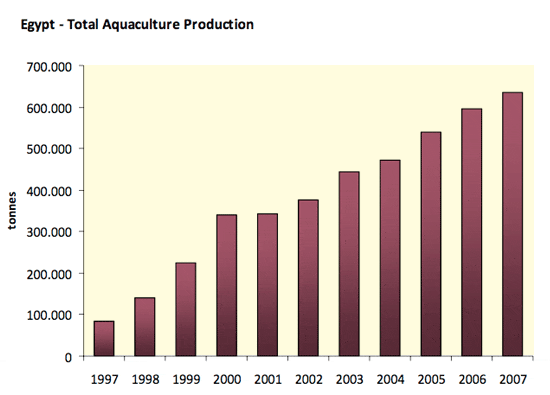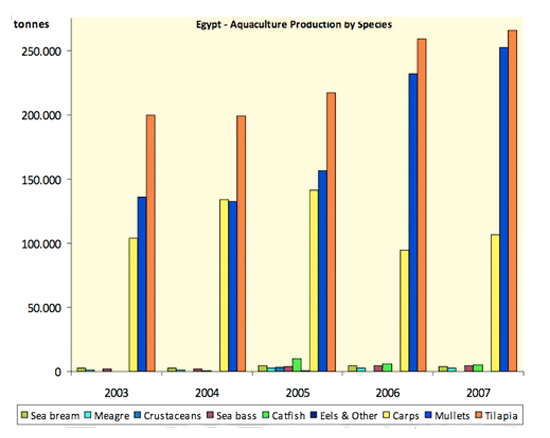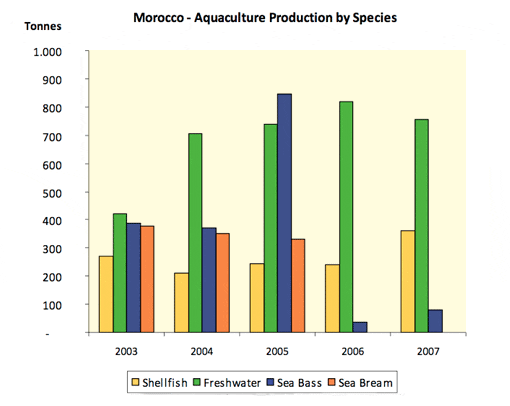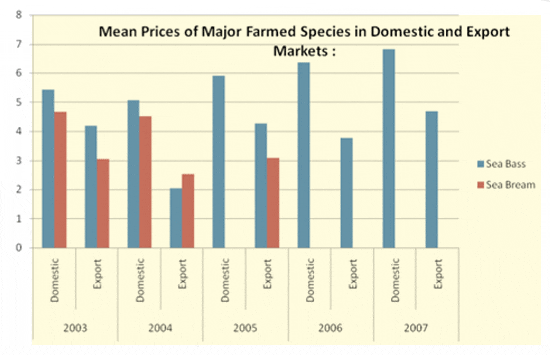Egypt
Egypt has more than 2 450 km of coastline, as well as 8 700 km2 of inland water: the Nile River with many irrigation canals, six northern coastal lagoons opening to the Mediterranean and two opening to the Suez Canal, and the great reservoir behind the Aswan's High Dam (Lake Nasser). Total seafood production, including fisheries and aquaculture, reached 1 008 million tonnes in 2007. Total aquaculture production in Egypt reached 635 517 tonnes in 2007 employing an estimated 160 000 people directly and directly. Aquaculture is currently the largest single source of fish supply in Egypt accounting for almost 61 percent of the total fish production of the country with over 98 percent produced from privately owned farms. The growth in production has been impressive over the past twenty years going from a production of 46 000 tonnes in 1987 to the current levels.
Figure 16 – Egypt: Total aquaculture production

Most aquaculture production in Egypt consists of semi-extensive or semi-intensive, freshwater or brackish water species in the Nile delta region, with tilapias, mullets and carps making up more than 97 per cent of total production in 2007. The common carp and flathead grey mullet were the first species to be introduced on an experimental basis in the mid 1930s. Common carps were extensively used in the government-financed national rice-cum-fish programmes, with juveniles distributed freely to rice farmers to be grown in the rice paddies. Grass, silver and bighead carps were introduced from Hungary in the late 1980s and are grown in ponds or cages in the Nile. The Nile tilapia, although a species native to Egypt, was not appreciated until the late 1980s and when found in ponds alongside other species was considered an accidental crop. It was only during the 1990s that the Nile tilapia was rediscovered as an important aquaculture species. The expansion in intensive tilapia aquaculture resulted in a boom in the development of privately-owned hatcheries and feed mill construction and since then Nile tilapia has become the most important aquaculture species. The farming of marine species such as European seabass, gilthead seabream, meagre and shrimp began in the late 1980s and early 1990s and still depends on the collection of juveniles from the wild (FAO Fisheries and Aquaculture and MedAquaMarket country profiles).
Figure 17 – Egypt:Aquaculture production for major species

Fish contribute to about 20 per cent of the national consumption of animal protein and the annual per capita consumption is about 12.73kg/person (NIFRD, 2005). Fish is a traditional and important component of the Egyptian diet, and is the main source of cheap animal protein for a growing population. Aquaculture integrated with rice production is considered by the Government as an indirect subsidy in animal protein consumption among the poorer rural population. Fish fingerlings purchased by the Government from different hatcheries are distributed free of charge to rice farmers. This ensures a supply of animal protein to farmers as the harvested fish are not marketed, but consumed directly by the farmers. Most of the catch is consumed fresh through domestic markets, with only small quantities exported. Fish consumption in Egypt is characterized by a longstanding traditional preference for fresh fish. In its development strategy, the Ministry of Agriculture and Land Reclamation plans to increase Egypt's total fish production to 1 500 000 tonnes by 2017 and is targeting a harvest of 1 000 000 tonnes from aquaculture. The sector is growing at levels exceeding those targeted in the plan. At the retail level, aquaculture products are sold alongside wild caught products. Farmed fish are considered to be inferior in quality by most consumers, although they are usually unable to differentiate between farmed and wild caught fish of the same species.
Limited industry with growth potential.
Morocco
Morocco has a small but varied aquaculture industry producing marine species (European seabass and gilthead seabream), freshwater species (trout, eel, carp, tilapia and crayfish) and shellfish (oysters and mussels).
Table 10 – Morocco: Aquaculture production
| Year | Volume (tonnes) | Value (€,000) | Value/kg (€) |
|---|---|---|---|
| 2003 | 1498 | 3983 | 2.66 |
| 2004 | 1680 | 4047 | 2.41 |
| 2005 | 2207 | 6302 | 2.86 |
| 2006 | 1111 | 1675 | 1.51 |
| 2007 | 1196 | 1871 | 1.56 |
The average production of fresh water and marine aquaculture sector in the period 2003–2007 is around 1 600 tonnes, divided almost equally between freshwater (750 tonnes) and marine aquaculture (850 tonnes). Aquaculture production remains very small compared to total fisheries production, less than 1 per cent of the total production of 900 000 tonnes in 2007.
Figure 18 – Morocco: Aquaculture production by species

The marine aquaculture industry in Morocco has stagnated in the past five years. Both feed and juveniles are imported, resulting in a very high relative cost of production as well as in a limitation on the per centage of production which can be sold in the domestic market (15 per cent with 85 per cent which must be exported). This remains the case even though prices for European seabass and gilthead seabream are higher in the domestic market than in the export market and the demand for domestic consumption is significant and increasing. In 2003, the price of European seabass in domestic market was €5.43/kg whereas for export it was €4.20/kg. In 2006, the price differential per kilo between the domestic and export markets was even more marked at €6.36 and €3.77/kg respectively. The same trend was observed for gilthead seabream.
Figure 19 – Morocco: Export vs. domestic market prices

As in other Mediterranean countries, the growth of the Moroccan aquaculture industry is limited by an onerous bureaucracy, the lack of good management and access to sites. It is additionally burdened by a lack of access to juveniles and feed, making it unable to compete in international export markets and unable to take advantage of a viable domestic market due to export obligations. It must compete in European markets where much larger producing countries enjoy both substantial economies of scale as well as substantial subsidies.
January 2011
